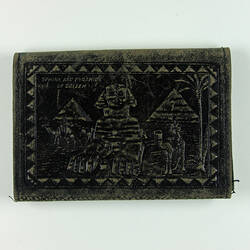Summary
Souvenir wallet from Egypt purchased during World War I. Depicts the Muhammad Ali mosque in Cairo and the Great Sphinx and pyramids of Giza. The wallet is scuffed, suggesting extensive use.
Albert was a 22-year-old unmarried clerk when he enlisted on 27 August 1914, service number 769, 3rd Battalion. He served in Gallipoli and later France, and was eventually promoted to the rank of corporal. He died in Bullecourt, France on 4 May 1917 and is commemorated at the Villers-Bretonneux Memorial. His brother John Peile was a 38-year-old unmarried miner when he enlisted on 25 June 1915, service number 2662, 2nd Battalion. He also served in in Gallipoli and France, and was similarly promoted to corporal. He died in France on 18 September 1918 and is buried at Roisel Communal Cemetery Extension, France. Their mother died only a few years later in 1926, aged 73. The service records of both men mention a wallet being sent home as part of their personal effects, although John's service record specifically mentions it being a 'leather wallet.'
The Mohammad Ali Mosque in Cairo was built between 1830 and 1848 in memory of Tusun Pasha, eldest son of Mohammad Ali Pasha, ruler of Egypt in the early-mid 19th century. The mosque was built in the Ottoman style by Greek architect Yussuf Bushnaq and is the largest Ottoman mosque of the early 19th century. It is built on the site of the old Mamluk Palaces, destroyed by Mohammad Ali, and houses the tomb of Mohammad Ali Pasha. Today it is one of the most popular Egyptian mosques for tourists.
The Great Sphinx is located on the Giza Plateau, along with the famous pyramids of Khafre, Khufu and Menkaure, all of which seem to have been a popular tourist destination for the troops during their time at Mena Camp.
This wallet was acquired as part of a collection of material relating to the World War I service of brothers John and Albert Victor Peile, who both died in the conflict.
Physical Description
Brown leather wallet, embossed on one side with an image of the sphinx and pyramids, and on the other. When open one side has an oval clear polymer window (buckled), with original image outline just visible, and is layered and divided to form separate pockets; the other side has two large pockets. A tab and corresponding loop would fasten the wallet closed. The loop is twisted and the exterior of the wallet scuffed, suggesting extensive use.
More Information
-
Collection Names
-
Collecting Areas
-
Acquisition Information
Donation from Victorian Branch, Returned & Services League of Australia Limited (RSL), Mrs Margaret J. Hitchens, 1986
-
Place Depicted
-
Place Depicted
-
Inscriptions
Embossed on one side, above image: 'MEHEMED - ALY / MOSQUE CAIRO'. Embossed on other side, above image: 'SPHINX AND PYRAMIDS / OF GUIZEH'
-
Classification
-
Category
-
Discipline
-
Type of item
-
Overall Dimensions
134 mm (Width), 8 mm (Depth), 95 mm (Height)
-
References
'Mohammad Ali (Alabaster) Mosque in Cairo,' TourEgypt.com, at: [Link 1] accessed: June 15, 2012 'Mohammad Ali Mosque,' Sacred Destinations, at: [Link 2] accessed: June 15, 2012 'Masjid Muhammad 'Ali al-Kabir,' ArchNet, at: [Link 3] accessed: June 15, 2012 Allen Winston, 'The Great Sphinx of Giza: An Introduction,' TourEgypt.com, at: [Link 4] accessed: June 15, 2012 For Albert Peile's war record see the National Archives of Australia website at: [Link 5]
-
Keywords



